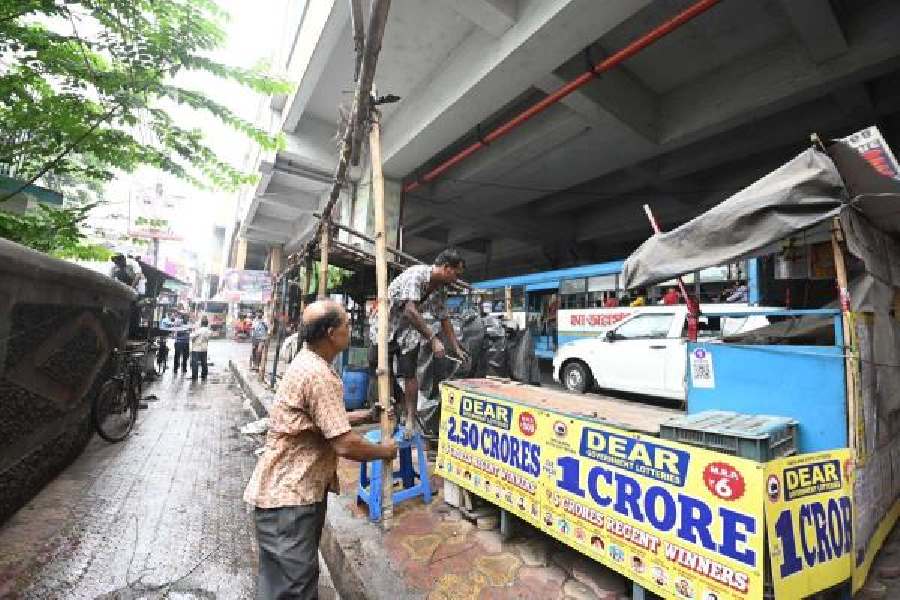Hawkers occupying the footpath along the stretch in Behala where eight-year-old Souraneel Sarkar was crushed under the wheels of a truck dismantled their stalls on Sunday following a police directive, but elsewhere in the city all crossings remained occupied by hawkers.
About 45 hawkers, who occupied a 50m-long stretch near the gate of Barisha Uchcha Balika Vidyamandir, where Souraneel was a student of Class II, dismantled their stalls on Sunday. The school is located on the campus of Barisha High School.
An officer of Behala police station said the hawkers were asked to vacate the stretch of the footpath so that there is more space for the students and their guardians near the school gate.
“The school will resume on Monday. If the footpath is clear, the guardians and students will have more space. We have asked them to clear the footpath near the school by tomorrow,” said the officer.
“The hawkers have been asked by the police to remove their stalls. About 45 stalls had to be shifted,” said Khokon Saha, a hawker leader.
The hawkers who have been asked to move can set up stalls in a lane about 100 metres from where they had stalls till Saturday, said Saha. “It is a blind lane,” Saha said, referring to the one where the hawkers have been asked to relocate. “Very few people enter that lane and hawkers will hardly get any customers.”
Though the pavement along the Behala school has been cleared of hawkers, similar hurdles for pedestrians exist barely 20 metres away. Stalls occupy most of the pavement and pedestrians are forced to walk through the Thakurpukur-bound stretch of Diamond Harbour Road.
Across Kolkata, the picture is similar despite mayor Firhad Hakim’s assertion that crossings should be made free of hawkers.
On Friday, Hakim said hawkers must not sit with their wares within 50 metres of important crossings. Hakim said he would write to the police so that the crossings were made encroachment-free.
The mayor was responding to questions about the lack of space for pedestrians on footpaths in the backdrop of the tragic death of the school student in Behala on Friday.
Hawkers occupying pavements at busy crossings and outside Metro stations is nothing new in Kolkata. The plan to make the footpaths in the immediate vicinity of all crossings hawker-free was mooted years ago.
In Gariahat, the police have carved out space from the road with guardrails for pedestrians, who are crowded out of pavements by hawkers’ stalls.
Some of the zebra crossings in Gariahat and Rashbehari crossings end in hawkers’ stalls, blocking the path for pedestrians to enter the footpath. There are poles supporting billboards, which further shrink the space of the footpath near the crossings.
A similar picture greets commuters in Esplande, Hatibagan, Shyambazar and in
almost all other busy crossings.
“The best way to know any city is to walk across it, but in Kolkata walking through pavements is a struggle,” said a south Kolkata resident.
Sources in the KMC said the mayor was likely to write to the police this week.
Debasish Das, a member of the town vending committee of Kolkata, said many crossings were cleared of hawkers in 2007, but vendors have since returned to the spots.
Each urban centre is supposed to have a town vending committee — made of hawkers, elected representatives, police officers and government officials, among others — which has the power to regulate hawkers and grant them certificates for vending.
The power has been bestowed on the committees by a central legislation — the Street Vendors (Protecting of Livelihood and Regulation of Street Vending) Act 2014.
The state government has framed a set of rules for hawkers. The rules say hawkers cannot occupy more than a third of the width of a pavement, cannot encroach on roads, cannot use plastic sheets and cannot set up stalls facing a road.
But across the city, the rules are violated with impunity. Hawkers occupy more than one-third width of pavements in many places.
In New Market, dozens of hawkers sit right on Humayun’s Place, Bertram Street and Lindsay Street.
